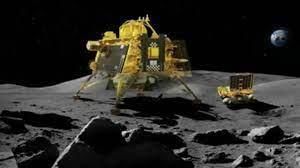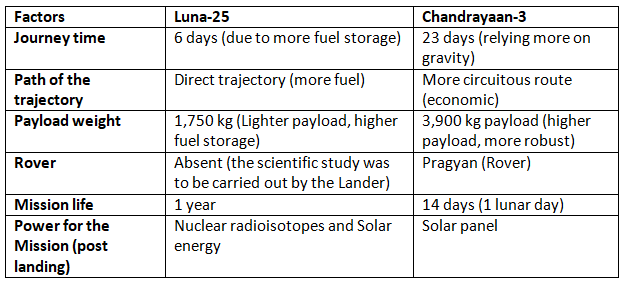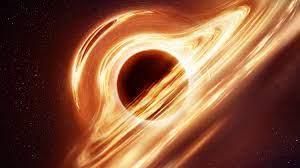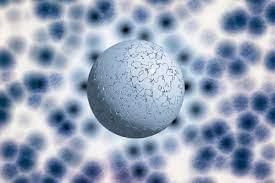Science & Technology - 1 | Current Affairs & Hindu Analysis: Daily, Weekly & Monthly - UPSC PDF Download
| Table of contents |

|
| Chandrayaan-3 |

|
| Black Holes |

|
| Neutrino Particles |

|
| UNAIDS Report: Progress & Challenges in HIV/AIDS Fight |

|
| Non-Sugar Sweeteners (NSS) |

|
Chandrayaan-3

Context
- The Chandrayaan-3 Mission marks the second endeavor by the Indian Space Research Organisation (ISRO) to showcase India's capability in safely landing and roving on the lunar surface, following the Chandrayaan-2 mission. On August 23, 2023, the Lander Module, comprising the Lander named Vikram and the Rover named Pragyan, achieved a historic soft landing on the Lunar South Pole. This accomplishment made India the first nation to softly land on the Lunar South Pole and the fourth globally to achieve a soft landing on Earth's natural satellite.
- Launched on July 14, 2023, from Sriharikota using the Geosynchronous Satellite Launch Vehicle Mark III (LVM3), the Chandrayaan-3 Mission aims to showcase India's prowess in soft landing and roving capabilities, along with conducting experiments on the lunar surface. The mission builds on the successes of its predecessors, Chandrayaan-1 and Chandrayaan-2, solidifying India's standing in the elite space exploration community and contributing to ongoing advancements in space discovery and innovation.
What is the Chandrayaan 3 Mission?
- The Chandrayaan 3 Mission was launched using the LVM3 rocket system. LVM3 is the new launch vehicle of ISRO with the capability to place the modules into the GTO (Geosynchronous Transfer Orbit) in a cost-effective manner.
- It is a three-stage launch vehicle with two solid strap stages and one core liquid stage. The Launcher, LVM3 M4, placed the integrated Modules in an Elliptic Parking Orbit of size approx. 170 x 36500 km (a GTO).
Objectives of Chandrayaan 3 Mission
One of the many goals of the Mission is to look for water ice that could support future human life on the Moon and also for supplying propellants for spacecraft in future interplanetary missions.
The objectives of the Chandrayaan-3 mission are:
- Safe and Soft Landing on the Lunar Surface by the Lander
- Roving on the Moon by the Rover
- In-situ scientific experiments by the Rover
Parts of the Chandrayaan 3 Mission
- The Chandrayaan-3 Mission consists of two modules - The propulsion module (PM) and the Lander module (LM). The total mass of both the modules is 3900 kg (Propulsion Module-2148 kg, and Lander Module-1752 kg, including Rover-26 kg).
Propulsion Module
- The propulsion module carried the lander and rover configuration till the 100 km lunar orbit. Other than carrying the Lander Module, it also has a scientific payload called Spectro-polarimetry of Habitable Planet Earth (SHAPE).
- The SHAPE payload will conduct novel spectro-polarimetric studies of Earth from lunar orbit. It will look for smaller planets that could be habitable in the reflected light.
Lander Module
- The Lander Module of the Chandrayaan-3 Mission comprises a Lander named Vikram and a Rover named Pragyan. The soft landing was achieved using the Automatic Landing Sequence (ALS), where the Lander initiated its thrusters to control speed, direction, and landing site position.
- After the historic landing, the Rover deployed from the Lander onto the lunar surface to conduct in-situ chemical analysis during its mission life, which spans the lunar day equivalent to 14 Earth days.
- Both the Lander and Rover are equipped with scientific payloads designed to perform experiments on the lunar surface. The objectives of the scientific payloads on the Chandrayaan-3 Lander Module and Rover are outlined below:
- Lander Payloads:
- Radio Anatomy of Moon Bound Hypersensitive Ionosphere and Atmosphere (RAMBHA):
- Objective: Measure plasma density fluctuations near the lunar surface.
- Chandra’s Surface Thermophysical Experiment (ChaSTE):
- Objective: Conduct thermal studies of the moon's frigid polar zones.
- Instrument for Lunar Seismic Activity (ILSA):
- Objective: Measure seismic activity to reveal the lunar crust-mantle configuration.
- LASER Retroreflector Array (LRA):
- Objective: Understand the dynamics of the Moon system.
- Radio Anatomy of Moon Bound Hypersensitive Ionosphere and Atmosphere (RAMBHA):
- Rover Payloads:
- Alpha Particle X-ray Spectrometer (APXS):
- Objective: Determine the chemical composition and mineral attributes of soil and rocks.
- LASER Induced Breakdown Spectroscope (LIBS):
- Objective: Analyze elemental constitution, providing insights into lunar geology.
- Alpha Particle X-ray Spectrometer (APXS):
Timeline of the Chandrayaan 3 Mission
- Launch Date: July 14, 2023
- Lunar Orbit Insertion: August 05
- Separation of Lander Module from Propulsion Module: August 17
- First Deboosting: August 18
- Explanation: Deboosting involves slowing down the spacecraft in an orbit with the Perilune (closest point to the Moon) at 30 km and the Apolune (farthest point) at 100 km from the landing site in the South Polar Region. This is necessary for a proper landing, as the speed required for landing is significantly less than that of the lander.
- Second Deboosting: August 20
- Soft Landing: August 23
- Landing Site: The targeted site on the Moon was approximately 70 degrees South, near the Southern pole. The actual landing coordinates were around 69.36°S and 32.34°E, situated between the Manzinus C and Simpelius N craters.
- Note: If the Lander had missed the target for the soft landing commencement, it would have had to wait for one month.
- Rover Exploration Commencement: August 24
What differentiates Chandrayaan 3 from Chandrayaan 2?
To enhance the chances of success for Chandrayaan-3, the Indian Space Research Organisation (ISRO) implemented several advancements based on the lessons learned from the Chandrayaan-2 mission failure in 2019. These improvements include:
- "Failure-based design" approach:
- Instead of a "Success-based design," the Chandrayaan-3 mission adopted a "Failure-based design" philosophy.
- This approach ensures that, even if all systems, including sensors and electronics, were to fail, the Lander (Vikram) would still achieve a soft landing.
- Various potential failure scenarios were identified and addressed, covering electronics failure, engine malfunction, inability to reach the landing spot, sensor failure, algorithm failure, excessive velocity, and more.
- Increased landing area:
- The target landing area for Chandrayaan-3 was expanded to a 4 km x 2.4 km zone, compared to the 500 m x 500 m target set for Chandrayaan-2.
- This enlargement provided the Lander with more options to autonomously select the optimal landing site.
- Additional fuel for the Lander:
- Chandrayaan-3 was equipped with more fuel for the Lander, enabling it to cover longer distances to reach the primary landing site and, if necessary, an alternate landing site.
- Utilization of Chandrayaan-2 orbiter data:
- Instead of carrying its own orbiter, Chandrayaan-3 leveraged high-resolution images from the Chandrayaan-2 orbiter for mission support.
- Enhanced integrated craft:
- The payload weight of Chandrayaan-3 was increased compared to Chandrayaan-2, with a focus on adding extra weight to the Lander for improved landing capabilities.
- The number of thrusters on the Lander was reduced from five to four, eliminating the central thruster.
- The Lander's legs were strengthened to ensure a successful landing even at higher velocities.
- Additional solar panels were incorporated to ensure power generation post-landing, regardless of lunar weather conditions.
Chandrayaan-3 vs Luna-25

These differences highlight variations in the mission designs, objectives, and capabilities of Luna-25 and Chandrayaan-3. Chandrayaan-3, with a higher payload and a rover, aims for a more comprehensive exploration of the lunar surface, while Luna-25 focuses on specific scientific studies using its lander. The choice of power sources and mission durations also reflects the distinct approaches taken by the two space agencies, Roscosmos and ISRO.
Significance of the Chandrayaan 3 Mission
- Future Lunar Exploration:
- Chandrayaan-3 plays a crucial role in India's pursuit of establishing a human presence on the moon.
- Collaboration with JAXA for the Lunar Polar Exploration mission (LUPEX) or Chandrayaan-4 is expected to benefit from the success of Chandrayaan-3.
- Advancing Space Education:
- The mission contributes to the advancement of space education and scientific knowledge in India.
- It serves as an inspiration for the scientific community and future generations of space enthusiasts.
- Lunar Surface Exploration:
- Building on Chandrayaan-2's achievements, Chandrayaan-3's lander and rover study rocks and soil to understand the moon's history.
- Focused on the moon's south pole, the mission aims to discover minerals, underground features, and water, providing fresh insights into moon geology and resources.
- Scientific Discoveries:
- Chandrayaan-3 carries tools to study moonquakes and underground heat, revealing the moon's interior.
- Seismometers on its surface and thermal probes uncover crust movements, deepening our understanding of the moon's geology and resources.
- Boosting Private Investment:
- The success of the Chandrayaan trio enhances investor confidence in India's aerospace technology sector.
- It attracts more private investment, fostering growth in the field-tech sector.
- Job Creation:
- India's booming aerospace technology sector, driven by successful lunar missions, creates numerous high-tech job opportunities.
- Nurturing Startups:
- Chandrayaan-3's success showcases India's technological capabilities, attracting joint ventures and business opportunities for Indian startups in the global space community.
- Strengthening International Reputation:
- Successful completion of Chandrayaan-3 establishes India as the fourth country to land on the moon, earning global recognition.
- It may lead to international cooperation and partnerships.
- Strategic Positioning:
- Chandrayaan-3's success positions India as a key player in the international space race, potentially rivaling China's influence.
- It provides an opportunity for India to strengthen its position, especially with Russia facing economic sanctions.
- Economic Benefits:
- Chandrayaan-3's success unlocks major economic benefits through investments, commercial contracts, and strategic positioning, contributing to India's emergence as a space leader.
- Overall, the mission holds tremendous significance for India's space endeavors, contributing to scientific exploration, economic growth, and strategic influence in the global space community.
Way Forward
As India continues to advance its space program through missions like Chandrayaan-3, it is imperative to chart the way forward strategically. While the moon presents new economic and technological possibilities, sustaining progress requires farsighted policies and practices.
- Lunar Economy Vision: This mission aligns with the global goal of a "lunar еconomy". Countries like the US, India, Russia, and China еnvision longer lunar prеsеncе, fostering economic benefits as well as space exploration development.
- Prospects for Dееp Spacе missions: Lunar gravity and atmosphеrе open doors for low-cost space launches in absence. The ability to use lunar resources for rocket propеllant could rеvolutionizе Thе interplanetary missions.
- Navigating orbital uncertainty: ISRO collaborates with the Inter-Agency Space Debris Coordination Committee (IADC) to ensure safe navigation, considering the risk of collision risk while orbiting the spacecraft. Sustainablе practices arе pivotal for thе еvolving cislunar and lunar еnvironmеnt.
- Advancing Spacе Policiеs: India's robust spacе policiеs, including thе Indian Spacе Policy (2023), stimulate private investments in spacе vеnturеs. Initiatives like the Anusandhan National Research Foundation encourage research and innovation.
- Transition to Sustainability: Prеvious missions wеrе financially еxtravagant, еnеrgy-intеnsivе, and prеcarious, with a nеarly 50% failurе ratе. In contrast, prеsеnt lunar missions leverage advanced technologies, matеrials, and safety protocols, ensuring higher success rates and cost-efficiency.
Chandrayaan-3 signifies a key milestone in global lunar exploration efforts, aligned with establishing a sustainable lunar presence driven by economic and technological incentives. India must seize this opportunity to advance scientifically, technologically and strategically by nurturing talent, enabling private participation and realizing possibilities for national growth.
Black Holes

Context
- Black holes are regions in space characterized by extreme density, creating intense gravitational forces. Their gravitational pull is so strong that even light, the fastest known entity, cannot escape from them.
- In essence, black holes are cosmic phenomena where an enormous mass is compressed into an extremely small volume, resulting in gravitational fields so powerful that nothing, including light, can break free.
A star devours a planet in a single gulp
- An intriguing event was reported where a dying star was consumed by a black hole. Initially, it was believed to be a gamma-ray burst from a collapsing star, but it proved to be different.
- Traditional gamma-ray bursts consist of a flood of high-energy photons rushing through space. They generally occur when a star explodes or when two objects collide.
- It's believed that most galaxies have black holes at their core. The burst originated from the center of a galaxy located four billion light-years away.
- Observations revealed that “The black hole was dormant until a star ventured too close, its gas got torn apart, and in the process, some of it got ejected.”
- Scientists have also discovered numerous planets with tight orbits that are destined to fall within the radius of red giants in the future.
Life cycle of stars
- The life cycles of stars are closely tied to their masses. Small stars, like red dwarfs, can shine for trillions of years, while the largest stars explode a few million years after their formation.
- When stars similar to the sun begin to die after billions of years, they evolve into a category known as red giants. These stars expand hundreds of times in size, engulfing anything within their expanding boundaries.
Importance of this discovery
- This discovery “offers a crucial piece of the puzzle in our understanding of the evolution and ultimate destiny of planetary systems,” including our own.
- It allows us to gain insights into astronomical events and the patterns governing the workings of galaxies and solar systems.
Neutrino Particles

Context
- The Indian Neutrino Observatory (INO) is a groundbreaking initiative aimed at establishing a cutting-edge underground laboratory dedicated to the exploration of fundamental scientific principles. This mega-science project is set to receive joint funding from the Department of Atomic Energy and the Department of Science and Technology. A unique feature of the INO Project is its extensive collaboration, involving nearly 100 scientists and 26 institutes, with the Tata Institute of Fundamental Research, Mumbai, serving as the hosting institution.
- The primary focus of the INO Project is the study of neutrinos, which are among the most abundant fundamental particles. This research involves the use of an underground Iron calorimeter (ICAL) detector to observe neutrinos originating from various sources.
What are the Neutrinos?
- A neutrino is a fundamental particle, devoid of any known smaller particles.
- Flavors of Neutrinos: Neutrinos come in different varieties or flavors. There are three known types: electron neutrino, muon neutrino, and tau neutrino.
- Properties:
- Neutrinos belong to the lepton family, the same category as electrons, which is a well-known fundamental particle.
- Among particles with mass, neutrinos are the lightest.
- Neutrinos are electrically neutral, distinguishing them from electrons.
- They interact with matter through the weak force, which contributes to their ability to pass through matter with minimal interaction.
- Neutrinos exhibit a unique property of oscillation, where different species of neutrinos can transform into one another as they travel through space.
- Sources:
- Neutrinos are the most prevalent massive particles in the universe, making them abundant.
- They are generated through processes like nuclear fusion in stars (such as the Sun) and particle decay in reactors.
- The Sun and other stars produce neutrinos through nuclear fusion and decay reactions in their cores.
- Neutrinos are also generated during the decay of heavy particles in various processes.
- Additional sources include exploding stars, relic neutrinos, natural radioactivity, and interactions with cosmic rays.
Need of INO
The INO project broadly aims to create an outstanding underground laboratory in India for non-accelerator-based high energy and nuclear physics research.
- To study the physics of the little-understood particles: Neutrino detectors around the world seem to see evidence that these weakly interacting particles are not really massless, as was thought so far.
- This has a significant impact on a variety of fields, including nuclear and particle physics, astrophysics, and cosmology.
- To detect masses of individual neutrino types: Neutrinos are the most numerous particles in the universe (other than photons), and even a small mass can impact the universe's evolution through their gravitational effects, making it crucial to understand the size of the three individual neutrino types.
- To study the evolution of the universe: Recent astrophysical measurements offer insights into the universe’s evolution, but it is crucial to explore neutrinos’ masses and properties directly for complementary information.
- To study the core of the Earth: Neutrinos can be utilised in neutrino tomography, a detailed investigation of Earth's structure from the core, as they are the only particles capable of probing the deep interiors of the Earth.
- Recapturing India’s pioneering studies on neutrinos: The planned Indian Neutrino Observatory is an attempt to recapture the pioneering studies on neutrinos at Kolar Gold Field (KGF), which detected the first atmospheric neutrinos in 1965. The closure of the mines forced the closure of this laboratory.
Importance of the Location of INO
The INO collaboration has decided on a site in the Bodi West Hills (BWH) region near Pottipuram village in Theni district of Tamil Nadu (110 km from the temple town of Madurai).
- Why underground?
- Because of their incredibly weak interaction with matter, neutrinos are very hard to detect in a laboratory.
- The background from cosmic rays and natural radioactivity will make it almost impossible to detect them on the surface of the Earth.
- The overburden provided by Earth matter is transparent to neutrinos, whereas cosmic rays are substantially reduced depending on the depth at which the detector is located.
- This is the reason most neutrino observatories are located deep inside the Earth's surface.
- Bodi Hills has been selected as the location because the Western Ghats' steep slopes offer ideal and stable rock conditions for creating a sizable underground cavern for long-term use.
- Close to the equator: Placing a neutrino detector close to the equator at an underground neutrino facility will help study solar neutrinos and their oscillations.
Iron Calorimeter Detector (ICAL)
The detector installed in the INO laboratory will be a magnetised iron calorimeter detector (ICAL).This non-moving static device will study the sky using neutrinos, much like a telescope studies the sky using visible light.
- Charged particles produced in the rare interactions of neutrinos with the iron (constituting the 50 kton, 1.3 Tesla magnet) will be detected in glass based detectors called RPCs sandwiched between successive iron layers.
What can the ICAL tell us about Neutrinos?
The INO project's Iron Calorimeter (ICAL) detector aims to contribute to the understanding of neutrino oscillations and several related phenomena.
Here are key aspects and potential contributions of the INO detector:
- Neutrino Flavor Mixing and Oscillations:
- Global experiments like Super-Kamiokande and SNO indicate that neutrino flavors mix and oscillate.
- ICAL is expected to provide more detailed insights by studying the "trough and peak" effect in the muon spectra from atmospheric neutrinos.
- Trough and Peak Effect:
- ICAL can establish the "trough and peak" effect by analyzing muon spectra, enabling accurate determination of oscillation parameters.
- Earth-Matter Effects:
- ICAL's ability to distinguish between neutrino and anti-neutrino events allows for the investigation of Earth-matter effects.
- The detector can study unknown oscillation parameters related to neutrino interactions with matter.
- Neutrino-Mass Hierarchy:
- ICAL aims to address the "neutrino-mass hierarchy," a phenomenon not yet well understood in neutrino physics.
- Far-Detector for Long-Baseline Experiments:
- ICAL can serve as a far detector for long-baseline neutrino experiments.
- This involves using a neutrino beam from a neutrino factory located in Japan, Europe, or the USA.
- Contribution to Global Neutrino Observatories:
- ICAL adds to the network of global neutrino observatories, contributing to the understanding of neutrino properties.
- Other observatories mentioned include Sudbury (Canada), Super Kamiokande (Japan), Gran Sasso Mountains (Italy), Soudan mines (USA), KATRIN experiment (Germany), Daya Bay Reactor Neutrino Experiment (Hong Kong), and IceCube Neutrino Observatory (Antarctica).
Significance of INO Project
- The INO project, despite facing opposition, holds significant importance for India due to various reasons:
- Multidisciplinary Science Facility:
- The INO project is expected to evolve into a comprehensive underground science facility covering diverse disciplines, including physics, biology, geology, and related engineering fields.
- It aims to become a premier Science and Technology Institution in India, contributing to advancements in various scientific domains.
- Dream Project of Indian Physicists:
- Alongside the LIGO India project, the INO is considered a dream project for Indian physicists.
- It represents a major aspiration for the scientific community in the country, emphasizing the pursuit of cutting-edge research.
- Global Contribution to High-Energy Physics:
- The INO project is designed to contribute to high-energy and nuclear physics projects globally.
- It positions India as a participant in international collaborations, fostering scientific cooperation and knowledge exchange.
- Educational Opportunities:
- Students from science programs across India are expected to actively participate in the development of sophisticated particle detectors and electronic data-acquisition systems for the INO.
- This offers valuable hands-on experience and educational opportunities in advanced scientific research.
- Technological Advancements:
- The use of modern technologies in the design and development of the INO contributes to advancements in technological infrastructure.
- It helps in nurturing a generation of scientists and engineers, strengthening the country's technological foundation.
- Applications in Medical Imaging:
- The detectors employed in the INO project have applications beyond particle physics, including medical imaging.
- Technologies developed for the project can potentially find applications in industries with broader societal impact.
While the project faces opposition from certain quarters, its potential contributions to scientific knowledge, education, and technological advancements underscore its significance for India's scientific community and broader development.
Current Status of INO Project
The Indian Neutrino Observatory (INO) has encountered uncertainty and opposition since its inception:
- Project Timeline:
- The INO project was conceptualized in 2005, with a site identified under the Bodi West Hills in Tamil Nadu's Theni district by 2009.
- A proposed fund of Rs 1,500 crore was suggested in 2015.
- The environmental approval from the Ministry of Environment came in 2018.
- Environmental Concerns:
- Opposition to the project arises from environmental experts who highlight that the chosen site falls within a tiger corridor, posing a potential threat to wildlife fragmentation.
- Construction activities such as blasting, excavation, tunneling, and transportation are expected to impact the local ecology and rock system.
- Threat to Tiger Corridor:
- The project's location within a tiger corridor raises concerns about the potential disruption of the natural habitat and movement patterns of wildlife.
- Impact on Local Ecology:
- Experts argue that construction-related activities can have adverse effects on the local ecology, disrupting the natural balance of the ecosystem.
- Radiation-Related Concerns:
- Some opposition to the project is based on myths and misconceptions related to radiation from neutrinos, which has been used as an argument against the observatory.
- Delay in Construction:
- Despite receiving environmental approval in 2018, the construction of the INO project has not commenced as of today.
- Opposition from ecologists and the state government has contributed to the delay in the initiation of construction activities.
- Public Opposition:
- Public sentiment and opposition, particularly from local communities and environmental activists, have played a role in delaying the project.
The INO project remains in a state of uncertainty, with challenges related to environmental impact, wildlife conservation, and public perception influencing its progress. The complex interplay of scientific goals and environmental concerns underscores the need for a balanced approach in addressing the issues surrounding the observatory.
UNAIDS Report: Progress & Challenges in HIV/AIDS Fight

Context
- The "The Path That Ends AIDS" report from the Joint United Nations Programme on HIV/AIDS (UNAIDS) highlights advancements, challenges, and ongoing efforts in the global battle against Acquired Immunodeficiency Syndrome (AIDS) and human immunodeficiency virus (HIV).
- The document underscores the importance of sustained endeavors to provide treatment access, tackle inequalities, eliminate stigma and discrimination, and secure sufficient funding.
What are the Key Highlights of the UNAIDS Report?
- AIDS-Related Deaths and Access to Treatment:
- AIDS claimed a life every minute in 2022.
- Approximately 9.2 million people living with HIV worldwide lacked access to treatment in 2022.
- Out of the 2.1 million people receiving treatment, many were not virally suppressed.
- Treatment Progress and Global Targets:
- 29.8 million out of 39 million people living with HIV globally are receiving life-saving treatment.
- Between 2020 and 2022, 1.6 million additional people received HIV treatment each year.
- The global target of 35 million people receiving HIV treatment by 2025 is within reach if the progress is sustained.
- Slow Treatment Progress in Certain Regions:
- Eastern Europe, Central Asia, the Middle East, and North Africa exhibited slower treatment progress.
- Only around half of the over two million people living with HIV in these regions received antiretroviral therapy in 2022.
- Gender Discrimination and Treatment Rates:
- Men living with HIV in sub-Saharan Africa, the Caribbean, Eastern Europe, and Central Asia are less likely to receive treatment compared to women.
- Gender discrimination needs to be addressed to ensure equal access to treatment.
- Impact on Children:
- AIDS-related deaths among children reduced by 64% from 2010 to 2022.
- However, approximately 84,000 children lost their lives to HIV in 2022.
- Around 43% of the 1.5 million children living with HIV did not receive treatment in 2022.
- AIDS-related deaths among children reduced by 64% from 2010 to 2022.
- Challenges in HIV Prevention:
- Women and girls accounted for 63% of all new HIV infections in sub-Saharan Africa.
- Only about 42% of districts with high HIV incidence in the region have dedicated prevention programs.
- Enhanced prevention efforts are needed to address this gap.
- Funding Gaps:
- HIV incidence has declined in regions with increased prevention funding.
- Eastern Europe, Central Asia, the Middle East, and North Africa face challenges in their HIV epidemics due to a lack of funding.
- In 2022, only USD 20.8 billion was available for HIV programs in low- and middle-income countries, falling short of the USD 29.3 billion required by 2025.
- Fluctuating Funding Levels:
- In the early 2010s, funding substantially increased, but it has since fallen back to 2013 levels.
- In 2022, there was a 2.6% drop in funding compared to the previous year, with only USD 20.8 billion available for HIV programs in low- and middle-income countries.
- The funding gap remains significant, as the required amount by 2025 is USD 29.3 billion.
What is AIDS Disease?
- About:
- AIDS is a chronic, potentially life-threatening health condition caused by HIV that interferes with the body's ability to fight infections.
- HIV attacks CD4, a type of White Blood Cell (T cells) in the body’s immune system.
- T cells are those cells that move around the body detecting anomalies and infections in cells.
- After entering the body, HIV multiplies itself and destroys CD4 cells, thus severely damaging the human immune system. Once this virus enters the body, it can never be removed.
- The CD4 count of a person infected with HIV reduces significantly. In a healthy body, CD4 count is between 500- 1600, but in an infected body, it can go as low as 200.
- Transmission:
- HIV spreads through contact with certain body fluids (blood, semen, etc.) from an infected person.
- Transmission routes include unprotected sex, sharing contaminated needles, and mother-to-child during childbirth or breastfeeding.
- Symptoms:
- Initial symptoms include fatigue, fever, and sores.
- Progression to AIDS may lead to severe symptoms like pneumonia and certain cancers.
- Prevention:
- Precautions can be taken to prevent mother-to-child transmission.
- Early diagnosis and treatment should be sought.
- Pre-marital testing can be considered, including an HIV test, for overall safety.
- Protective techniques should be used to ensure safety from Sexually Transmitted Diseases.
What are India’s Initiatives to Curb AIDS Disease?
- HIV and AIDS (Prevention and Control) Act, 2017:
- Mandates central and state governments to implement measures to prevent HIV or AIDS spread.
- Access to ART:
- India ensures affordability and accessibility of Antiretroviral Therapy (ART) for over 90% of global HIV-positive individuals.
- Memorandum of Understanding (MoU) - 2019:
- MoU signed between Ministry of Health and Family Welfare and Ministry of Social Justice and Empowerment.
- Aims to enhance HIV/AIDS outreach.
- Focus on reducing social stigma and discrimination against victims of drug abuse and Children and People Living with HIV/AIDS.
- Project Sunrise - 2016:
- Launched by Ministry of Health and Family Welfare.
- Addresses rising HIV prevalence, especially among people injecting drugs, in northeastern states of India.
Non-Sugar Sweeteners (NSS)

Context
The World Health Organization (WHO) released new guidelines on May 15, 2023, cautioning against the use of non-sugar sweeteners (NSS) such as aspartame, saccharin, stevia, and their derivatives as a "healthy" substitute for sugar. In its 'conditional' guideline, the WHO advises against utilizing non-sugar sweeteners for weight control or reducing the risk of diet-related non-communicable diseases. The attention on NSS heightened after the WHO's 2015 statement linking high free sugar intake to weight gain and obesity, prompting consumers to turn to NSS as an alternative.
About non-sugar sweeteners
- Non-sugar sweeteners (NSS) are marketed as low or no-calorie alternatives to free sugars which aid in weight loss, and in controlling blood glucose in individuals with diabetes
- NSS categories studied by WHO include acesulfame K, aspartame, advantame, cyclamates, neotame, saccharin, sucralose, stevia, and stevia derivatives
- Aspartame is popularly used to sweeten diet colas that claim to have ‘no sugar, no calories.’ Saccharin is used to sweeten tea or coffee.
WHO findings
- The WHO analysed a total of 283 studies on the intake of NSS in adults and children
- The outcome of the trials was that they noted ‘higher intake’ of NSS was associated with a 76% increase in risk of obesity and a 0.14 kg/m2 increase in BMI (Body Mass Index)
- The WHO warned that long-term use of NSS could lead to increased risk of Type 2 diabetes, cardiovascular diseases, chronic kidney disease and cancer
- Studies are required because currently the evidence cited by the WHO on non-sugar sweeteners has been categorised into either moderate, low or very low certainty
- Moderate certainty indicates that WHO is moderately confident about the risks and that the true effect is likely to be close to the estimate, but there is a possibility that it is substantially different.
- To prevent unfettered consumption of artificially sweetened products like chocolates and colas, as consumers tend to over-indulge in these with a perception that they may be better than sugary products
Concerns
- Health experts stress the importance of guiding people in India on non-sugar sweeteners (NSS) due to alarming obesity rates, with one in nine women and one in 25 men reported as obese in the latest National Family Health Survey.
- According to WHO data, obesity increases the risk of diabetes, affecting an estimated 25 million people with pre-diabetes in India.
- A representative from the food industry, focusing on products with no added sugar, highlights the priority of developing items that taste sweet with similar palatability.
- WHO cautions against viewing the role of NSS in isolation in weight loss studies, emphasizing the crucial consideration of the quality (nutritional profile) and quantity of the diet.
- The organization recommends choosing alternative foods such as minimally processed, unsweetened options.
- WHO's analysis suggests that weight loss attributed to the switch from sugars to NSS in some cases also depends on reduced portion sizes or overall energy intake of food.
Way forward
- The Ministry of Health will have to initiate discussions among policy-makers before it decides to adopt this ‘conditional’ recommendation as a national policy.
- The WHO recommends that with the help of this guideline, efforts should be made, with a focus on youngsters, to tweak taste preferences and eating behaviours.
|
38 videos|5275 docs|1115 tests
|
FAQs on Science & Technology - 1 - Current Affairs & Hindu Analysis: Daily, Weekly & Monthly - UPSC
| 1. What is Chandrayaan-3? |  |
| 2. What are black holes? |  |
| 3. What are neutrino particles? |  |
| 4. What does the UNAIDS report on HIV/AIDS fight entail? |  |
| 5. What are non-sugar sweeteners (NSS)? |  |















